8 Inspiring Psychological Safety Examples for Teams in 2025
Psychological safety stands as a top priority for high-performing teams in 2025, shaping how organizations adapt and succeed. In today’s hybrid and diverse workplaces, fostering a culture where team members feel safe to speak up is the foundation for innovation, engagement, and well-being. Yet, many leaders struggle to translate theory into practice, making psychological safety examples essential for real-world results. In this post, discover eight powerful psychological safety examples that will give you actionable insights to transform your team and create an environment where every voice truly matters.
Understanding Psychological Safety in Modern Teams
In 2025, psychological safety is the cornerstone of thriving teams. This concept has evolved from a buzzword into a non-negotiable part of modern workplace culture. Psychological safety means that individuals feel safe to express ideas, ask questions, and admit mistakes without fear of negative consequences. For a foundational overview, see What is psychological safety. This shift is crucial as organizations become more dynamic, diverse, and collaborative.
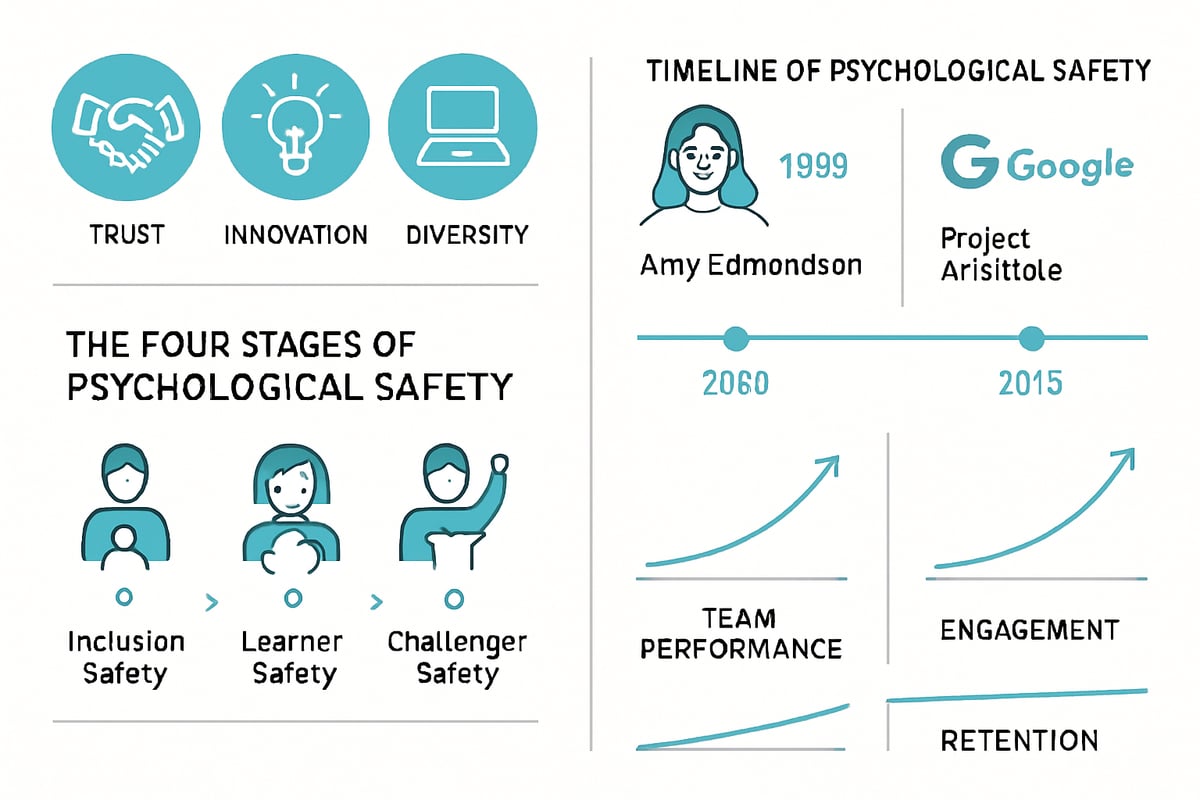
Amy Edmondson’s research brought psychological safety into the spotlight. Her studies revealed that teams with high psychological safety outperformed others, regardless of talent or resources. Google’s Project Aristotle confirmed this, naming psychological safety as the top predictor of team effectiveness. These findings have shaped how leaders view psychological safety examples, making it a priority for innovation and growth.
Today’s teams are more remote, hybrid, and multicultural than ever before. Psychological safety examples show that trust and open communication are essential for these groups. Without it, misunderstandings and disengagement can quickly take root. Teams that invest in psychological safety adapt faster, embrace feedback, and drive creative solutions across different locations and cultures.
The connection between psychological safety and team performance is clear. Google found that psychological safety is the number one factor in successful teams. Teams with strong psychological safety examples report higher creativity, retention, and engagement. A recent study showed that organizations prioritizing psychological safety see up to 30% more innovation and significantly lower turnover rates.
It’s important not to confuse psychological safety with a lack of accountability. True psychological safety examples involve honest conversations, constructive feedback, and holding each other to high standards. It is not about avoiding difficult topics or letting poor performance slide.
Consider a global software company that struggled with project delays and low morale. After leadership introduced regular feedback sessions and encouraged open discussion of mistakes, the team’s trust and productivity soared. This real-life shift highlights the power of psychological safety examples to transform outcomes.
Psychological safety develops in stages: inclusion safety (feeling accepted), learner safety (comfortable asking questions), contributor safety (confidently sharing ideas), and challenger safety (able to challenge the status quo). Teams that nurture all four stages create environments where psychological safety examples thrive and every member can reach their full potential.
8 Inspiring Psychological Safety Examples for Teams in 2025
The most effective teams in 2025 are those that actively nurture psychological safety. When leaders understand what this looks like in practice, it becomes much easier to transform intent into action. Below, you’ll find eight compelling psychological safety examples that illustrate how organizations are building trust, promoting open communication, and driving innovation in real-world settings.
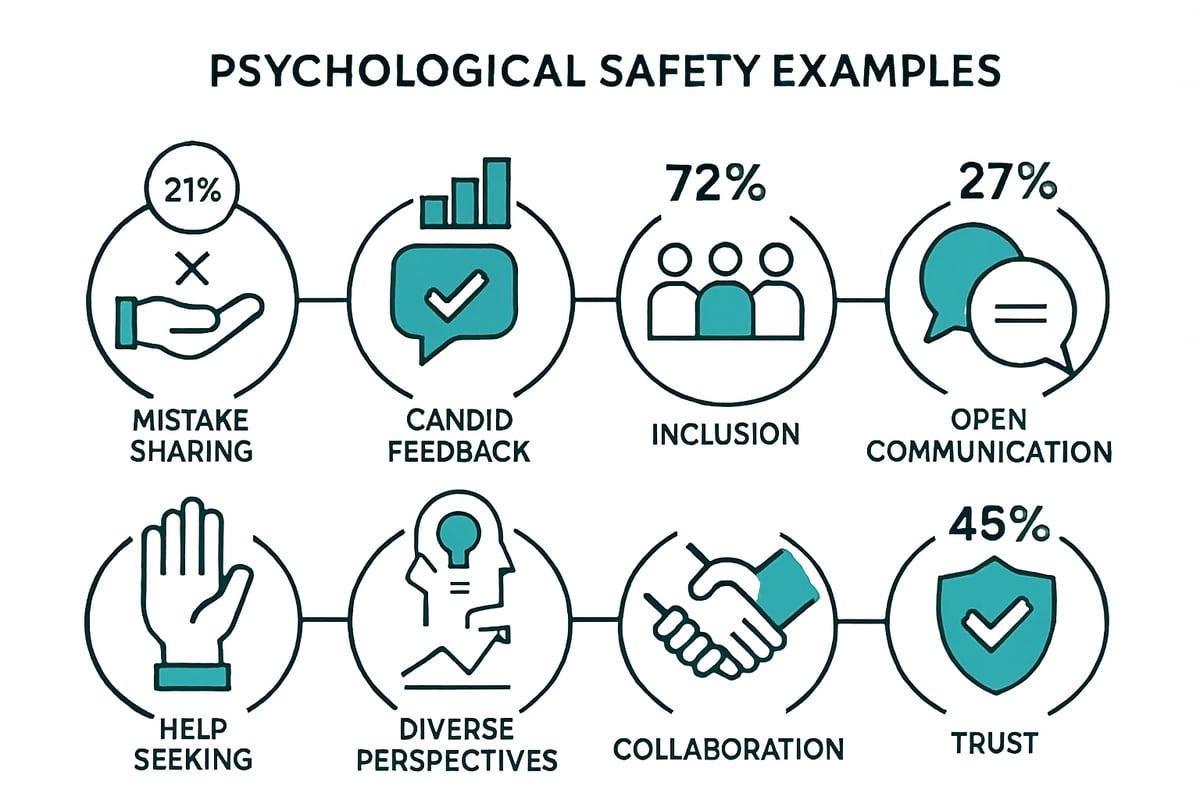
1. Embracing Mistakes as Learning Opportunities
Teams that thrive in 2025 treat mistakes not as failures, but as essential building blocks for growth. This approach is at the heart of many psychological safety examples you see in today’s top-performing organizations.
Leaders set the tone by openly discussing their own missteps. For instance, in a leading tech company, managers kick off monthly “failure forums,” where team members share what didn’t work and what they’ve learned. This habit normalizes vulnerability and signals that learning outweighs blame.
A standout example comes from a software development team that celebrates a “failure of the month.” The story behind each mistake is shared, along with the creative solutions that emerged as a result. This ritual encourages experimentation and destigmatizes risk-taking.
Data backs up the impact: Organizations that normalize mistakes report 30% higher engagement, demonstrating the real value of these psychological safety examples. To put this into practice, start meetings with a “lesson learned” session. Rotate who shares each time, ensuring everyone participates.
When mistakes are reframed as learning opportunities, teams become more agile and innovative. They adapt quickly, solve problems faster, and continuously raise the bar for performance. This is one of the most actionable psychological safety examples leaders can implement today.
2. Encouraging Candid Feedback and Open Dialogue
Honest, respectful feedback is a cornerstone of psychological safety. Among the most effective psychological safety examples is the practice of creating open feedback loops, where every team member feels empowered to challenge ideas and offer constructive criticism.
Leaders who model this behavior actively solicit input and create space for dissenting opinions. Take the case of a marketing team that uses regular “red team” exercises. Here, a subgroup plays the role of critical evaluators, stress-testing strategies and surfacing blind spots.
Psychological safety surveys consistently reveal higher levels of trust in teams with robust feedback practices. In fact, 75% of employees report feeling more valued when their feedback is acted upon. These psychological safety examples foster transparency and reduce groupthink.
To build this habit, try the “ask twice as much as you tell” technique in meetings. Invite questions, probe for alternative viewpoints, and thank contributors for their candor. Over time, this leads to stronger decisions and a more engaged team.
For more real-world insights on fostering open dialogue and feedback, visit Psychological safety in the workplace, which explores additional practical psychological safety examples.
3. Sharing Personal Stories and Building Empathy
Among the most powerful psychological safety examples are those that humanize team members and build empathy. When people share personal stories, connections deepen, and trust grows.
Teams often begin meetings with “Check-in Circles,” where each person can share a recent experience or emotion. Participation is always voluntary, but the practice creates space for understanding and compassion. One remote team dedicates the first five minutes of every call to “life updates,” helping colleagues feel seen and heard.
Research shows that teams who regularly share personal stories exhibit higher trust and resilience, two critical outcomes of strong psychological safety examples. These conversations break down barriers and foster belonging.
Guidelines are important: Respect boundaries, never force participation, and ensure that stories are met with empathy, not judgment. Over time, this approach cultivates a culture where all voices matter and psychological safety flourishes.
The result? Teams are more resilient, supportive, and ready to face challenges together. These psychological safety examples remind us that authentic connection is a performance multiplier.
4. Modeling Vulnerability by Leaders and Managers
True leadership today means showing up with authenticity and humility. Some of the most effective psychological safety examples involve leaders who model vulnerability.
For example, a manager might share their own development journey during a team meeting, openly discussing both strengths and areas for growth. This transparency signals to the team that it’s safe to be imperfect and to ask for help.
Data from PsychSafety.com shows a direct correlation between leader vulnerability and increased team trust. Leaders who regularly ask for feedback on their own performance set a powerful example. This breaks down traditional stereotypes that leaders must always have the answers.
Practical tactics include: scheduling regular “ask me anything” sessions, inviting feedback after key decisions, and sharing stories about overcoming past mistakes. These psychological safety examples help teams see leaders as approachable and relatable.
The impact is profound. Teams become more willing to take smart risks, raise concerns, and contribute bold ideas. When leaders lead with vulnerability, psychological safety becomes woven into the team’s DNA.
5. Creating Safe Spaces for Challenging the Status Quo
High-performing teams don’t just accept the status quo. They are encouraged to question processes and propose improvements, making this one of the most critical psychological safety examples in modern organizations.
One effective method is the “Challenge Session,” a dedicated forum where anyone can suggest changes without fear of repercussions. Google’s Project Aristotle found that challenger safety is vital for innovation and long-term success.
Techniques like anonymous suggestion boxes or digital forums empower introverted team members to participate fully. Data shows that teams with robust challenger safety are twice as likely to implement breakthrough ideas.
To foster this, schedule regular sessions to review current practices and invite fresh perspectives. Celebrate those who speak up, and visibly implement suggestions when possible. These psychological safety examples drive continuous improvement and adaptability.
In summary, creating safe spaces for dissent is essential for teams that want to stay agile and innovative in 2025.
6. Promoting Inclusion and Reducing Power Gradients
Inclusion is more than a buzzword; it’s a key driver of psychological safety. Some of the most impactful psychological safety examples come from teams that deliberately reduce power gradients.
For instance, rotating meeting facilitators empowers junior team members and ensures every voice is heard. This practice helps address the challenge of “the wrong person in the room,” where dominant voices can unintentionally stifle participation.
Data from PsychSafety.com indicates that diverse teams with high psychological safety outperform their peers by 35%. Inclusive decision-making and transparent communication are central to these psychological safety examples.
Practical steps include: using a round-robin approach for input during meetings, publishing clear agendas, and making decision processes transparent. These actions flatten hierarchies and create a culture of belonging.
The result is higher engagement, more creative solutions, and a team where every member feels valued and respected. These psychological safety examples are foundational for high-performing, diverse teams.
7. Recognizing Effort and Giving Credit Where Due
Recognition is a powerful motivator and a central theme in many psychological safety examples. When leaders consistently acknowledge contributions, team morale soars.
Public recognition during all-hands meetings is one practical approach. Avoiding self-aggrandizing behaviors and ensuring that credit is given where due are hallmarks of psychologically safe teams.
LeaderFactor reports that 80% of employees are more motivated when their efforts are recognized. Peer-nomination systems, where colleagues highlight each other’s achievements, add another layer of authenticity to these psychological safety examples.
To implement this, set aside time in team meetings for shout-outs and celebrate both big wins and incremental progress. Documenting successes in a shared space can also reinforce a culture of appreciation.
The impact is clear: morale improves, retention increases, and teams feel a stronger sense of value and belonging. These psychological safety examples create an environment where people are inspired to do their best work.
8. Supporting Autonomy and Avoiding Micromanagement
Empowering team members to own their work is a defining feature of modern psychological safety examples. Trust, rather than surveillance, is the foundation of high-functioning teams.
A shift from micromanagement to coaching-based leadership is central here. Managers provide clear expectations and support but resist the urge to control every detail. This approach has been shown to boost psychological safety and job satisfaction.
One example: A product team transitioned to a model where members set their own goals and check in regularly, rather than waiting for top-down direction. Evidence shows that such teams enjoy reduced turnover and higher engagement.
Best practices include setting clear objectives, offering resources, and stepping back to let people execute. These psychological safety examples empower employees to innovate and take calculated risks.
When team members feel trusted, their confidence grows and creativity flourishes. Autonomy is a catalyst for both well-being and high performance.
Summary Table: Psychological Safety Examples in Action
| Example | Key Practice | Impact |
|---|---|---|
| Embracing Mistakes | Open learning from errors | Higher engagement, innovation |
| Candid Feedback | Open dialogue, constructive input | Better decisions, trust |
| Personal Story Sharing | Empathy, connection | Stronger bonds, resilience |
| Leader Vulnerability | Transparency, feedback-seeking | Authenticity, risk-taking |
| Challenging Status Quo | Safe forums for dissent | Continuous improvement |
| Inclusion & Power Gradient Reduction | Rotating roles, transparent choices | Greater creativity, engagement |
| Recognition & Credit | Public praise, peer nominations | Motivation, retention |
| Autonomy & Coaching | Trust, clear expectations | Empowerment, satisfaction |
To see how these psychological safety examples can be implemented step by step, organizations like Accountability Now offer additional resources for teams committed to lasting change.
Practical Strategies to Foster Psychological Safety in 2025
Fostering psychological safety in modern teams takes intention, structure, and continuous effort. Leaders and organizations must focus on proven methods to ensure everyone feels secure to contribute. Here are practical strategies—rooted in real-world psychological safety examples—to help you embed these principles in your team.
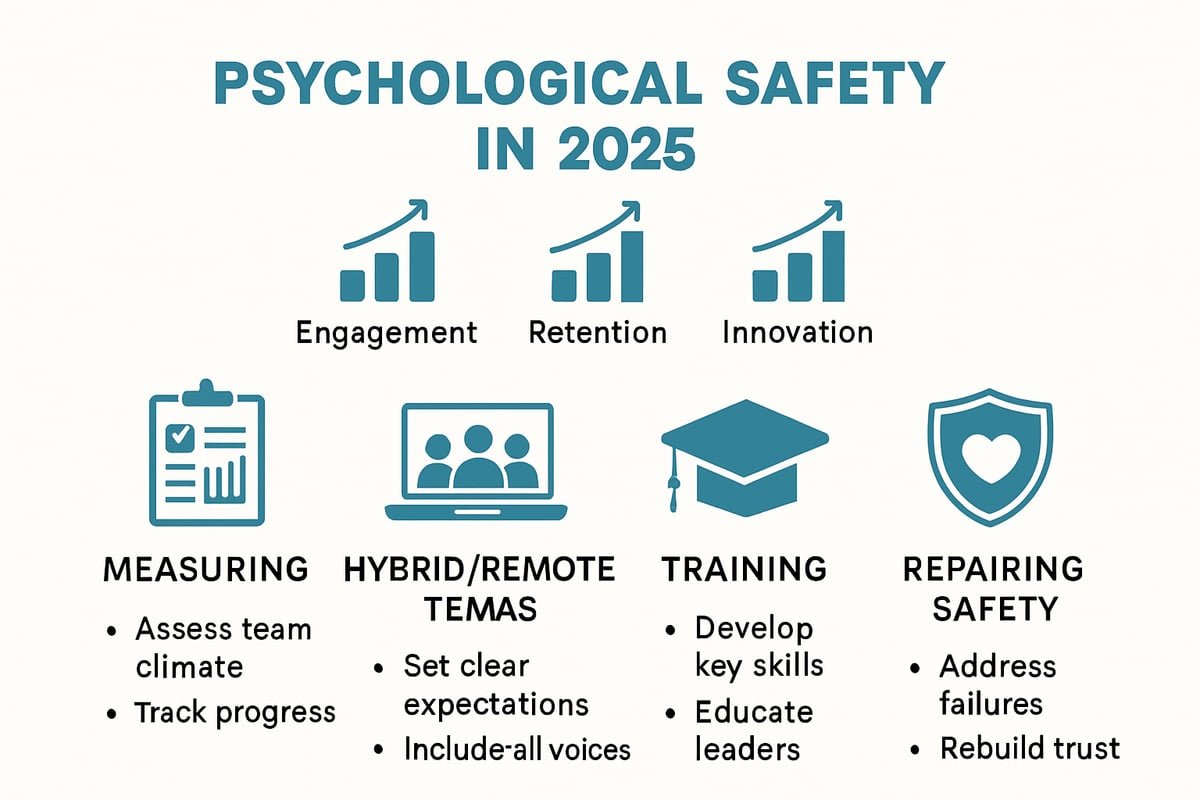
Assessing and Measuring Psychological Safety
Begin by evaluating your team’s climate with targeted surveys and pulse checks. Use questions that gauge openness, willingness to admit mistakes, and comfort in sharing ideas. Google’s Project Aristotle identified psychological safety as the top driver of team success—review their findings on team effectiveness for practical tools and benchmarks.
After collecting data, analyze trends and identify areas needing attention. For example, compare your team’s scores to industry standards or to other internal teams. This step transforms psychological safety examples from theory into actionable metrics.
Table: Key Survey Questions
| Area | Example Question |
|---|---|
| Openness | “Can you raise problems without fear?” |
| Inclusion | “Are diverse views welcomed?” |
| Accountability | “Is it safe to admit mistakes?” |
Use feedback to create a targeted action plan, ensuring the team understands the purpose and sees results from the process.
Building Psychological Safety in Hybrid and Remote Teams
Distributed teams face unique challenges, especially when nonverbal cues are missing. To overcome this, implement virtual check-ins and asynchronous feedback channels. Digital suggestion boxes and rotating facilitators help surface all voices.
Effective psychological safety examples include global teams using “virtual open door” hours, making leaders more accessible. Encourage regular “life update” moments to keep remote members connected. These small but consistent actions foster trust and belonging, regardless of location.
List: Best Practices for Remote Teams
- Schedule regular one-on-ones
- Create anonymous digital feedback forms
- Use video meetings to enhance connection
By prioritizing inclusion and visibility, hybrid teams can thrive and innovate.
Training and Development for Leaders and Teams
Effective psychological safety examples show that training is not a one-time event. Offer ongoing workshops and simulations that reinforce psychological safety principles. Role-play scenarios can help team members practice difficult conversations in a safe environment.
Include psychological safety modules in onboarding so new hires understand expectations from day one. Encourage leaders to attend specialized training to model vulnerability and inclusive leadership. Peer coaching circles are another proven way to reinforce these behaviors.
Table: Training Methods and Benefits
| Method | Benefit |
|---|---|
| Workshops | Deepens understanding, builds skills |
| Simulations | Safe space to experiment and learn |
| Peer Coaching | Sustains accountability and growth |
Continuous development ensures psychological safety remains a living, evolving practice.
Addressing Barriers and Repairing Damaged Psychological Safety
Barriers like bullying, broken trust, or unchecked power dynamics can undermine even the best intentions. Recognize these issues early by monitoring feedback and acting quickly. Use restorative conversations to address breaches and rebuild trust.
HR and leadership should set clear processes for reporting and resolving issues. Psychological safety examples from organizations like Accountability Now show the value of strong response systems. Reinforce your commitment by communicating openly about steps taken to repair and strengthen the team climate.
Action Steps:
- Respond quickly to reported issues
- Facilitate open forums for discussion
- Provide resources for ongoing support
By proactively addressing challenges, teams can restore safety and move forward with greater resilience.
Real-World Case Study: Psychological Safety in Action
In 2025, one global technology firm set out to transform its workplace culture by applying psychological safety examples at every level. The company’s leadership noticed that innovation was stalling and turnover rates were creeping up. Diverse teams struggled to share ideas, and remote members felt left out.
To address these issues, the executive team turned to Amy Edmondson psychological safety research and Google’s Project Aristotle for inspiration. They realized that fostering psychological safety would be the foundation for higher performance and engagement. Leaders began modeling vulnerability, admitting their own mistakes, and inviting feedback in regular “failure forums.” This transparency encouraged team members to share their perspectives and challenge the status quo.
The company implemented several psychological safety examples drawn from the research. For instance, they created rotating facilitators for meetings, set up anonymous suggestion channels, and recognized both effort and learning from failure. Leaders attended workshops to learn how to support autonomy and avoid micromanagement. These steps aligned with the four stages of psychological safety: inclusion, learner, contributor, and challenger.
The impact was immediate and measurable. Teams reported a 25% increase in idea submissions, and employee engagement scores soared. Turnover dropped by 18% within a year. Most importantly, employees described feeling empowered to speak up and experiment, which led to a surge in innovation and well-being. These outcomes echo the findings from Project Aristotle, which identified psychological safety as the number one driver of team effectiveness.
For organizations seeking similar results, it’s crucial to prioritize psychological safety examples that fit their unique culture. Leaders should be proactive, consistent, and open to learning. To explore more actionable strategies and frameworks, resources like Accountability Now provide valuable support for teams on this journey.
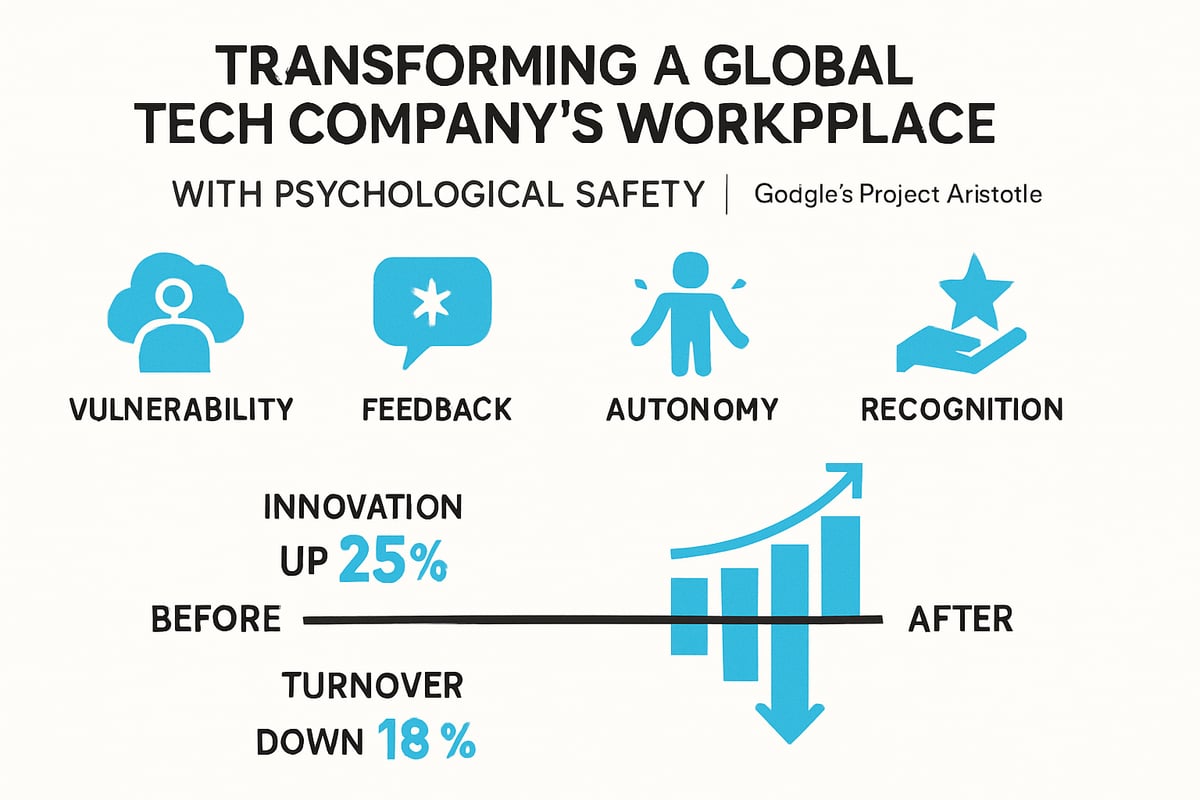
Resources and Further Reading on Psychological Safety
For leaders and teams eager to dive deeper into psychological safety examples, a wealth of research and practical tools are available. Start with Amy Edmondson’s foundational research on psychological safety, which lays the groundwork for understanding team learning and performance. Explore frameworks like The 4 Stages of Psychological Safety for actionable steps.
You can also find valuable toolkits and survey templates on sites like Accountability Now, supporting ongoing improvement. Join professional communities, attend webinars, and keep learning to foster a culture where psychological safety examples fuel lasting success.

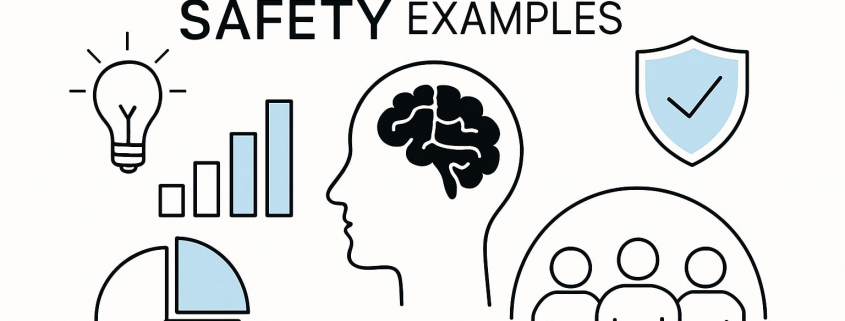


Leave a Reply
Want to join the discussion?Feel free to contribute!